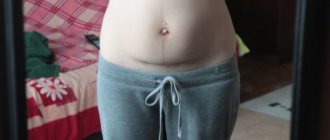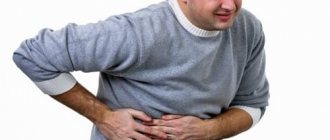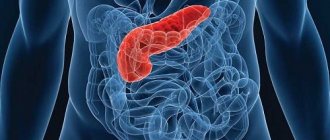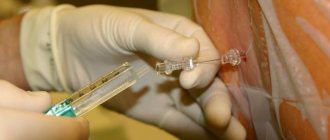Complications
As after any surgical intervention, a woman after a CS will have to go through a period of rehabilitation. After all, in order to remove the child from the uterus, the surgeon cuts the skin on the abdomen and internal organs layer by layer, then applies sutures. Therefore, it is quite logical that after a cesarean section the stomach hurts and discomfort occurs.
In the first few days, while the young mother is in the intensive care unit, painful sensations are considered normal. At this time, they are treated with medications prescribed by the attending physician. In addition, the woman in labor can be given vitamin compounds to generally strengthen the body, and antibiotics to minimize the risk of inflammatory processes in the uterus. Sometimes it is necessary to infuse patients with blood plasma if there has been blood loss.
How long does your stomach hurt after a cesarean section?
1 monthfrom 2 months
After 3-4 days, the pain is significantly dulled, and after another week it should not be there at all. Otherwise, it is imperative to consult a doctor, especially when painful sensations are accompanied by high fever, strange discharge from the suture, or red secretion with an unpleasant odor from the vagina.
The reasons why abdominal pain occurs at first after a cesarean section may be different. Here everything depends on the age of the woman, and on how many births she had previously, how the pregnancy proceeded, and the process of delivery itself.
So the problem may be caused by:
- Features of postpartum suture healing. The anesthesia used during surgery does not leave the body immediately. Therefore, the first few hours after the baby is born, the young mother may not feel pain at all. But when the anesthesia wears off completely, the wound will bother you for quite a long time. The intensity of pain can vary depending on the pain threshold of an individual woman and the number of uterine surgeries she has undergone. If a CS was done for the first time, then the suture will take longer to heal and ache than for a second-bearing mother. Severe painful symptoms should normally disappear after three days, but tingling in the suture area can take up to two weeks to make itself felt.
- Malfunctions of the intestines. The accumulation of gases in the intestines is a common occurrence after a CS. This can cause severe discomfort and bothersome abdominal pain. The bottom line is that any operation causes disturbances in peristalsis. As a result, food moves slowly, bloating begins, causing sharp and sharp pain. The reason may also be the formation of postpartum adhesions that appear between the internal organs and intestinal loops.
- Involution of the uterus. It is known that after natural delivery the uterus begins to contract, and because of this, pain occurs in the lower abdomen, very similar to those that accompany menstruation. Despite the fact that with CS the process of giving birth to a baby is radically different, the body’s reaction is the same in both cases. That is, the uterus is also actively contracting and the sensations are similar. The primary influence on the process is the hormone oxytocin, which is intensively produced by the body during lactation. If the pain is unbearable and continues constantly, you should definitely inform your doctor about it to exclude possible complications.
- Physiological processes. Immediately after a CS, the suture may react with acute pain to the slightest movement, be it even inhalation and exhalation, sneezing or coughing. You need to try to endure these unpleasant sensations and, despite the discomfort, minimize the time spent in a lying position, since the lack of physical activity only further delays the recovery process.
- Complications. Among the most possible is endometritis or, in other words, an inflammatory process in the uterine cavity. We also cannot rule out seam divergence, which will certainly cause severe pain.
I have listed just a few factors that most often cause pain. There can be many more reasons and they are all individual. It is impossible to make a diagnosis remotely, relying only on the woman’s feelings and general symptoms. Therefore, a detailed examination and testing are necessary measures.
We have already discussed one common complication that occurs after a cesarean section and can cause acute pain. This is endometritis - inflammation in the uterine cavity. The postpartum suture can also become inflamed and even break apart, and this process is also accompanied by acute pain. We recommend that you carefully listen to the nature of the pain after a cesarean section; if it intensifies and becomes unbearable, it is recommended to immediately consult a doctor, because this may indicate a serious problem.
Pain in the lower part after surgery is considered a natural phenomenon. During natural childbirth, contractile movements occur in the uterus for some time, which leads to nagging pain, similar to menstrual pain. The pain symptom intensifies during breastfeeding. During the process, a hormone is produced in the female body that promotes contraction of internal female muscles.
For longer and more persistent discomfort, you should consult a doctor. This symptom may indicate disorders in the uterus, an internal inflammatory process.
Discomfort is caused by the seam. The healing process of tissues after damage is long and always accompanied by unpleasant sensations. Sudden movements, turns, even coughing or sneezing create sharp, fast-passing pain.
The scar's intense sensitivity to stress persists for a week, then subsides. Pharmacies sell a bandage to reduce pain and pressure on the tissue located next to the suture; women in labor are advised to wear it.
As healing progresses, a scar appears on the body, creating a dull and stabbing pain. After a cesarean section, a woman should monitor the healing of the wound and ensure that no inflammation or purulent discharge appears at the incision site.
Intestines
After abdominal surgery, a mother may complain of abdominal pain due to intestinal dysfunction. Anesthesia is used during surgery. The drugs affect the small and large intestines. As a result, gas formation increases and the motor activity of the tract worsens. Abdominal bloating and delayed bowel movements cause discomfort and pain to the mother in labor.
Lack of bowel movements leads to constipation and a feeling of heaviness in the stomach. To normalize bowel function, a woman must follow a diet. It is possible to prescribe medications that promote rapid excretion of feces and cleanse the intestinal tract.
Unpleasant sensations are caused by the disturbed position of the internal organs. During pregnancy, the uterus, along with the fetus, enlarged and moved apart the organs located inside the abdominal cavity. After a cesarean section and extraction of the fetus, the uterus did not contract and continues to put pressure on the intestines. The stomach, shifting, puts pressure on nearby organs. The process continues for two days, and the location of the insides becomes normal.
The incision through which the child is taken out means a rupture of nerve connections - innervation. Therefore, for a long time, the young mother feels numbness in the lower abdomen under the stitch. As the nerve connections are restored, the numbness gradually goes away. Nerve endings take much longer to heal and connect than normal tissue. The process takes up to 1 year.
Discomfort in the abdomen can occur due to disorders that have arisen inside the uterus or in nearby organs.
Postoperative complications are divided into two types: damage to internal organs due to postoperative sutures and individual intolerance to anesthesia.
Violations due to seams are manifested by external signs:
- The scar feels hard to the touch;
- There is swelling in the incision area;
- The abdomen becomes enlarged and bloated.
With the body's natural reaction, the hard scar and swelling will disappear after 1 year. A small fold of skin may appear above the seam; this is normal in the absence of unpleasant sensations.
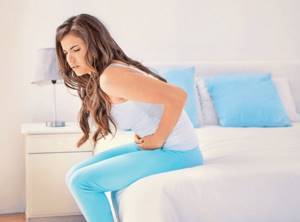
Redness of the suture area is a sign of scarring of immature connective tissue, suppuration, inflammation or fistula. A good doctor will provide qualified assistance.
Keloid scars appear as a result of infection in the wound, hormonal imbalances, or decreased immunity. A keloid scar differs from a normal scar in its pain and internal itching sensation. At the site of fusion of immature connective tissue, pulsation is observed, the skin stretches and numbness of the skin is felt.
A woman needs to understand that the appearance of keloid scars and growing connective tissue subsequently have an unaesthetic appearance. Medicine has learned to cope with the situation. The patient is prescribed electrophoresis and offered pressure bandages. A drastic solution is possible - surgical removal.
It is possible that an infection may get into the seam if there is no antiseptic treatment. Infection manifests itself:
- Body temperature rises.
- Swelling appears in the area of the incision, and the seam turns red.
- Purulent fluid leaks out.
An infection in the suture interferes with the regeneration process, which leads to skin separation after removal of the threads. The woman herself often achieves the same result when she lifts weights or strains her stomach.
The occurrence of fistulas is associated with infection or an allergic reaction to the materials of the suture threads. Manifested by external signs:
- A lump appears under the skin, causing pain when touched.
- Redness around the incision.
- Purulent fluid leaks through the suture.
It is necessary to seek medical help; prolongation leads to tissue inflammation, the formation of a purulent area and an abscess.
Back and lower back pain
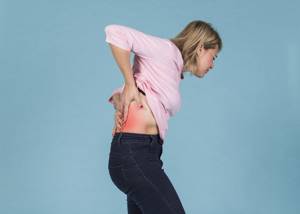
In obstetrics, there are many cases where a woman in labor has a back pain after a cesarean section. This is natural, because the back area and spinal column bear increased load during pregnancy. Doctors identify several reasons that contribute to back problems in nursing mothers.
Neurological Pain
Muscle strain, pinched nerve endings, problems with the joint system are possible postpartum pathologies.
Clinical picture of a young mother:
- lower back pain after cesarean section, especially when moving or lifting heavy objects;
- Sharp and sudden “shots” occur.
Headache

Spinal anesthesia used by obstetricians and gynecologists has a significant side effect - the risk of post-puncture (postdural) headache (PDPH).
Studies have shown that one of the “provocateurs” of headaches after cesarean section are needles for puncture of the largest caliber.
Manifestations of cranialgia are well known in medicine:
- pain of a pulsating nature, bilateral and symmetrical;
- headache constantly;
- in the “lying” position, the intensity of the pain onslaught decreases, and in the “standing” position – vice versa.
In the case of PDPH, the head may hurt after a cesarean section from several days to two weeks. In general, the prognosis is considered favorable. The vast majority of cases resolve on their own. In some cases, unpleasant consequences remain and require medical intervention.
In the maternity ward, specialist doctors always take into account the general condition and information in the medical history of the admitted patient as part of the differential diagnosis.
Along with post-injection cranialgia in a woman in labor, the following may be detected:
- migraine – intense unilateral headaches, photophobia, odor aversion, nausea;
- hypertension - heaviness and pain in the fronto-occipital part of the head, feeling of heat, tachycardia;
- infectious meningitis - increased body temperature, headache, cervical numbness, blurred vision, vomiting.
Women who suffered from headaches before pregnancy are under special medical supervision.
After examination and diagnosis, the patient is prescribed symptomatic therapy using medications.
The success of recovery after a cesarean section depends on the specific diagnosis, the course of prescribed therapy, individual characteristics and the general condition of the female body.
Surgical childbirth is a difficult test for the female body. However, if you follow all medical instructions, take a responsible attitude towards your own health and receive attention from your family, this period will end happily for the young mother.
Photo: ru.freepik.com, pixabay.com/ru
Sides hurt after cesarean
Some mothers have pain in their sides after a cesarean section. What is this connected with?
Common reasons
ACS is an abdominal surgical intervention that disrupts the structure and functions of the internal systems of the body. Pain in the sides of various types is often observed after surgery. Their causes are adhesions, temporary intestinal dysfunction and diseases of other etiologies.
With a narrower examination, specific pathologies are identified that are prerequisites for right-sided or left-sided pain syndrome.
